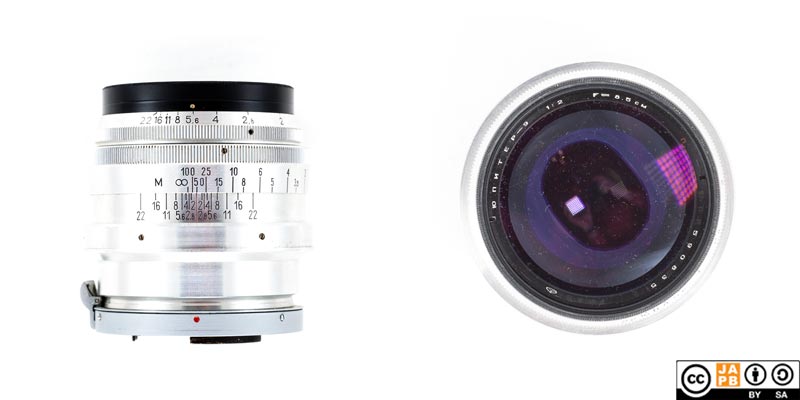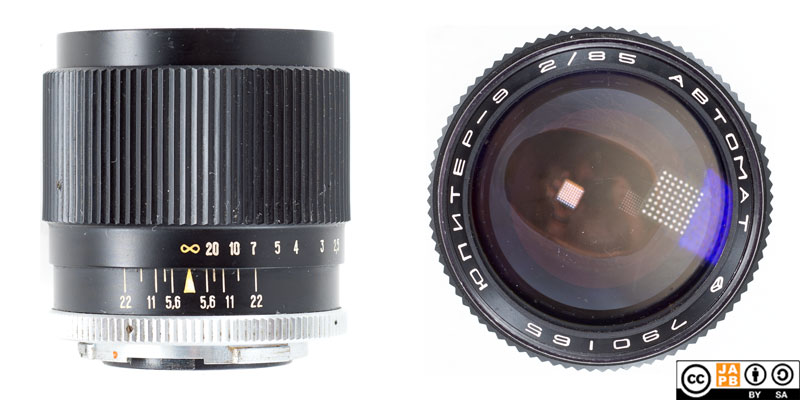Pekka Buttler, 09/2023 (Updated: 03/2025)
Introduction to the Jupiter-9
The Jupiter-9 is a Soviet version of the Carl Zeiss Sonnar 85/2 (Introduced 1932). While the German original was produced only for Contax rangefinder cameras, the Jupiter-9 was produced both for the Soviet versions of the Contax (Kiev rangefinders) as well as Soviet versions of the Leica (FED & Zorki rangefinders). Later even versions for Z39 and M42 cameras as well as Kiev 10/15 series cameras were introduced.
The Jupiter-9 was produced by a broad range of Soviet optics factories, including KMZ, Arsenal and LZOS. Because Soviet production of the Jupiter-9 started with parts taken as war reparations from Germany, the optical design was somewhat unstable in the early years. After the first few years, all parts were Soviet-built.
The lens was single-coated from the onset, but at some stage in the 1980s multicoating was introduced. I have not managed to find conclusive information of when manufacture of the lens was ended.
This data sheet summarizes covers the Jupiter-9 Design in its entirety, but presents samples in both Contax/Kiev and Kiev automat mounts.
Specifications (Contax/Kiev)

The table below summarizes the lens’ key specifications (measurements based on pictured lens):
| Manufacturer: | Arsenal | Lens name | Юпитер-9 / Jupiter-9 2/85 |
| Focal length(s) 1 | 85 mm | Angle-of-view 2 | 28 ° |
| Maximum Aperture | f/2 | In Production | 1946–≈? (all variants) 1946-≈1980s (Contax/Kiev variant) |
| Lens mounts (this lens) | Contax/Kiev | Other lens mounts | Leica thread mount, Z39, M42, Kiev automat |
| Length 3 | 64,6 mm | Diameter 4 | 61,8 mm |
| Filter ring diameter | 49 mm | Weight | 343 grams |
| Lens element count | 7 | Lens group count | 3 |
| Aperture blades (S/R/C) 5 | 15 S | Focus throw | 200 ° |
| Minimum focusing distance | 1,15 m | Maximum magnification | 1:11,4 |
| Has manual aperture ring | YES | Has Manual focus ring | YES |
| Aperture mechanism type | Manual | Aperture click stops | None. |
Notes on the Contax/Kiev variant:
• The pictured sample is a relatively early sample.
• The aperture ring is clickless and fully manual.
Specifications (Kiev Automat)

The table below summarizes the lens’ key specifications (measurements based on pictured lens):
| Manufacturer: | Arsenal | Lens name | Юпитер-9 / Jupiter-9 2/85 Abtomat |
| Focal length(s) 1 | 85 mm | Angle-of-view 2 | 28 ° |
| Maximum Aperture | f/2 | In Production | 1946–≈? (all variants) 1965–≈1980 (Kiev automat variant) |
| Lens mounts (this lens) | Kiev automat | Other lens mounts | Contax/Kiev, Leica thread mount, Z39, M42 |
| Length 3 | 55,0 mm | Diameter 4 | 54,8 mm |
| Filter ring diameter | 49 mm | Weight | 287 grams |
| Lens element count | 7 | Lens group count | 3 |
| Aperture blades (S/R/C) 5 | 8 S | Focus throw | 150 ° |
| Minimum focusing distance | 116 cm | Maximum magnification | 1:11,7 |
| Has manual aperture ring | NO | Has Manual focus ring | YES |
| Aperture mechanism type | Controlled by camera | Aperture click stops | None |
Notes on the Kiev automat variant:
• The Kiev automat variant of the Jupiter 9 is relatively compact.
• Having been designed for the Kiev 10/15 series of cameras, the lens lacks an aperture ring (aperture was designed to be controlled by the camera). This has implications for adapting (see below).
History of Jupiter and other Soviet lenses
If you’re interested, I recommend you read JAPB’s article about the Soviet lens ‘business’.
Versions
Besides three significantly different versions for the two rangefinder mounts and the m42 mount, this lens also progressed a bit during its prodigious production run, with the last variants featuring period-adequate multicoating.
History of the Sonnar designs
The Sonnar designs were originally born out of necessity. Back before the invention of lens coating technology, each air-glass boundary represented a serious problem. Every air-glass boundary meant roughly 5% of the light that would hit such a boundary would be bounced back, instead of passing through the boundary. This not only meant that each air-glass boundary would decrease the amount of light that passed through the lens to the film plane, a goodly portion of that reflected light was liable to be bounced around within the lens, leading to veiling flare and loss of contrast. Hence, design a lens to minimise the number of lens groups was crucially important.
Until the invention of the Sonnar design, the only ways to produce large aperture lenses were based on the double-Gauss (a.k.a. Planar) and Ernostar designs, both of which were hampered by that the number of air-glass boundaries were relatively high (a minimum of 8). The Ernostar was the 1924 creation of the young (then only 23 years old) lens designer Ludwig Bertele for the company Ernemann. At the time of its launch it was – at f/2 – the fastest still camera lens in existence, and one year later Bertele bested his previous record with the f/1.8 Ernostar.
After Carl Zeiss acquired Ernemann in 1926, Ludwig Bertele continued pushing the boundaries and the Sonnar was a further development of the Ernostar. Not only did the Sonnar in 1932 manage to achieve an even larger maximum aperture (at f/1.5), it did so while simultaneously decreasing the number of lens groups to 3 (hence decreasing the number of air-glass boundaries to 6). It seemed like the perfect solution.
Bertele developed a range of Sonnar-based designs: Standard lenses for rangefinder cameras (that did not necessitate a long back focal length) and tele lenses (for both rangefinders and SLRs). Some of those tele lenses were relatively ‘ordinary’ in their headline specifications (e.g. 135 mm f/4) but ahead of other contemporary lenses in their image quality, whereas other designs were clearly aimed at producing exceptionally bright tele lenses (such as the 85/2 or 180/2.8).
Adapting
This chapter will discuss adapting the Contax/Kiev and Kiev Automat versions of the lens.
If you want to adapt an M42 mount version of the lens, see the JAPB article on the M42 mount. If you want to adapt a leica thread mount version of the Jupiter-9, see the JAPB article on the LTM mount. If you want to adapt a Z39 mount version of this lens, your best bet is a Z39->M42 adapter ring and then treating it as a M42 mount lens.
Adapting a Contax/Kiev version
To use this lens natively, you will need either a Contax rangefinder body or a Kiev rangefinder body. Of these, the Kiev rangefinder bodies were produced in greater numbers, and their production also continued long past the end of production of Contax rangefinders. On the other hand, quality at the Kiev plant was never quite up to German standards, and Kiev bodies are more likely not to have had proper maintenance. In an absolute pinch, you can even mount this lens on a Nikon S series, but be prepared that the rangefinder will be off a bit.
If your intention is to adapt this lens to a mirrorless camera, that is certainly possible, but you will need an adapter that offers the lens the Contax/Kiev mount’s external bayonet. Luckily external bayonet adapters are more common than internal bayonet adapters (or adapters that offer both bayonets). However, the range of available adapters is not as wide as with some of the more common SLR mounts (e.g. Canon FD …) and you should not expect special adapters (helicoid adapters, tilt/shift adapters, speed boosters) to be available.
Due to the short flange focal distance used by the Contax/Kiev mount, there is no meaningful way to adapt this lens to any SLR or dSLR.
Adapting a Kiev Automat version
Should you want to use this lens in its original environment, you need a functioning Kiev 10/15 series SLR body. This will not be easy as a) the Kiev 10/15 cameras were never manufactured in high numbers; b) most bodies have suffered substandard maintenance.
You can adapt Kiev Automat lenses to all mirrorless cameras assuming you can procure (or make) an adapter. Such adapters can either be based on parts from a Kiev 10/15 camera body, or 3D-printed. Cottage industry 3D printed adapters can be found on online sales platforms for many mirrorless mounts.
Using Kiev Automat lenses on SLRs and dSLRs is troublesome. Technically there are only a few SLR mounts that have both a shorter Flange focal distance than that of the Kiev Automat mount and a throat diameter sufficient for the mechanics an adapter would necessitate, namely Canon FD and Konica AR. Of these The Canon FD-approach is proven to be workable.
Footnotes
- Focal length is (unless stated otherwise) given in absolute terms, and not in Full-frame equivalent. For an understanding of whether the lens is wide/tele, see ‘Angle-of-view’. ↩︎
- Picture angle is given in degrees (based on manufacturers’ specs) and concerns the diagonal picture angle. Rule of thumb:
> 90 ° ==> Ultra-wide-angle
70–90 ° ==> Wide-angle
50–70 ° ==> Moderate wide-angle
40–50 ° ==> ‘Standard’ or ‘normal’ lens
20–40 ° ==> Short tele lens
10-20 ° ==> Tele lens
5-10 ° ==> Long tele lens
< 5 ° ==> Ultra-tele lens ↩︎ - Length is given from the mount flange to the front of lens at infinity. ↩︎
- Diameter excludes protrusions such as rabbit ears or stop-down levers. ↩︎
- S=straight; R=rounded; C=(almost)circular at all apertures. ↩︎
- Focal length is (unless stated otherwise) given in absolute terms, and not in Full-frame equivalent. For an understanding of whether the lens is wide/tele, see ‘Angle-of-view’. ↩︎
- Picture angle is given in degrees (based on manufacturers’ specs) and concerns the diagonal picture angle. Rule of thumb:
> 90 ° ==> Ultra-wide-angle
70–90 ° ==> Wide-angle
50–70 ° ==> Moderate wide-angle
40–50 ° ==> ‘Standard’ or ‘normal’ lens
20–40 ° ==> Short tele lens
10-20 ° ==> Tele lens
5-10 ° ==> Long tele lens
< 5 ° ==> Ultra-tele lens ↩︎ - Length is given from the mount flange to the front of lens at infinity. ↩︎
- Diameter excludes protrusions such as rabbit ears or stop-down levers. ↩︎
- S=straight; R=rounded; C=(almost)circular at all apertures. ↩︎